
Illustration of trees, cones, and foliage [Matt Strieby, 2021].
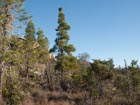
Tree ca. 6 m tall near the edge of a recent burn, Bonny Doon, California [C.J. Earle, 2014.01.20].
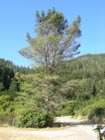
Open-grown tree on the Klamath River floodplain, California [C.J. Earle, 2009.07.03].

New shoot and pollen cones on a tree at Rancho Santa Ana Botanic Garden [C.J. Earle, 2004.04.13].
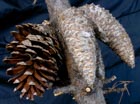
Pinus attenuata cones from trees in habitat, Klamath River basin [C.J. Earle, 2009.07.12].
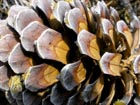
Detail of an opened cone [C.J. Earle, 2009.07.12].
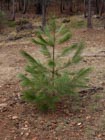
Sapling nearly a meter tall, in habitat, Siskiyou Mountains, Oregon [C.J. Earle, 2011.01.30].
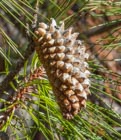
Mature cone on a tree in habitat, Palomar Mtn., California [C.J. Earle, 2012.12.20].
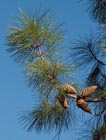
Mature cones and foliar units on a tree in habitat, Palomar Mtn., California [C.J. Earle, 2012.12.20].

Seedling ca. 30 cm tall near the edge of a recent burn, Bonny Doon, California [C.J. Earle, 2014.01.20].
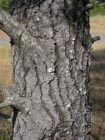
Bark on a tree 30 cm diameter, Klamath River basin, California [C.J. Earle, 2009.07.03].

Conservation Status

Pinus attenuata
Lemmon 1892
Common names
Knobcone pine (Kral 1993).
Taxonomic notes
Syn: Pinus tuberculata Gordon 1849, not D.Don 1836; P. tuberculata var. acuta Mayr (Millar 1986, Kral 1993).
It hybridizes naturally with P. radiata to produce P. × attenuradiata Stockwell & Righter; the type of this name was an experimental hybrid specimen.
Description
Tree to 24 m tall or, on very poor sites, a shrub; dbh to 80 cm, trunk usually straight; crown usually conic. Bark purple-brown to dark brown, shallowly and narrowly fissured, with irregular, flat, loose-scaly plates, on upper sections of trunk nearly smooth. Branches ascending, shoots slender, red-brown. Leaves three per fascicle, spreading or ascending, persisting 4-5 years, (8-)9-15(-20) cm × (1-)1.3-1.8 mm, straight or slightly curved, twisted, yellow-green, all surfaces with fine stomatal lines, margins serrulate, apex abruptly conic-subulate; sheath (1)1.5-2 cm, base persistent. Buds ovoid to ovoid-cylindric, dark red-brown, aging darker, ca. 1.5 cm, resinous; scale margins fringed, apex attenuate. Pollen cones ellipsoid-cylindric, 10-15 mm long, orange-brown. Seed cones remain closed for 20 years or more, or open on burning; in whorls, hard and heavy, very asymmetric, lanceoloid before opening, ovoid-cylindric when open, 8-16 cm, yellow-brown or pale brown, sessile or on a peduncle to 1 cm; maturing in 2 years. Cone scales with apophyses toward outside base increasingly elongate, mammillate or raised-angled-conic, downcurved near base, scarcely raised on branchlet side, rhombic; umbo central, low-pyramidal, sharp, upcurved. Seeds compressed-oblique-obovoid; body ca. 6-7 mm, nearly black; wing narrow, to 20 mm. 2n=24 (Kral 1993, M.P. Frankis e-mail 1999.03.06). See García Esteban et al. (2004) for a detailed characterization of the wood anatomy.
Distribution and Ecology
USA: Oregon & California, specifically: "In the Coast Range maountains of southern Oregon and northern California (on the Siskiyou Mountains, Trinity Alps, Mount St. Helena Summit, etc.), on the Santa Cruz Mountains, on Point Pinos, near Carmel, Monterey County, and the eastern slopes of the Santa Lucia Mountains, Monterey County; on Mount Shasta (4000 to 5600 feet); on the west slopes of the northern Sierra Nevada, at 1500 to 4500 feet, south to the south side of the San Bernardinos at 2500 to 4000 feet. Lacking otherwise in the southern Sierra Nevada and southern Coast Ranges (Peattie 1950). Also in Mexico: Baja California Norte. Fire successional on dry slopes and foothills (Kral 1993). Hardy to Zone 7 (cold hardiness limit between -17.7°C and -12.2°C) (Bannister and Neuner 2001). See also Thompson et al. (1999).
Distribution data from USGS (1999).
Remarkable Specimens
The former big tree champion fell in 2010 (Luke Ruediger e-mail 2011.05.08); it was 109 cm dbh, 36 m tall, crown spread 20 m, located in Shasta County, CA (American Forests 1996). The California big tree registry has not named a new champion, but Oregon's largest tree is 95 cm dbh, 35.6 m tall, and has a crown spread of 15.5 m (Ascending the Giants 2011).
I have no age data for trees in habitat, but in cultivation in Britain, this species is not known to exceed about 80 years (M.P. Frankis e-mail 1999.06.03).
Ethnobotany
USDA hardness zone 7 (inland Oregon origins), otherwise zone 8.
Observations
Besides the specific range notes given above, Arno and Gyer (1973) specify several locales around Yosemite National Park and it is also found in dry associations with Sequoia sempervirens at Redwood National Park (ICE Flora and Fauna Database).
Remarks
"Pinus attenuata, mostly a chaparral species, bears cones at an early age. Its seed crops are heavy, and a hot fire permits the seeds to be released. It forms hybrids with P. muricata and P. radiata" (Kral 1993).
This species is the only common host of the dwarf mistletoe Arceuthobium siskiyouense (Hawksworth and Wiens 1996).
Citations
American Forests 1996. The 1996-1997 National Register of Big Trees. Washington, DC: American Forests.
Arno, Stephen F. and Jane Gyer. 1973. Discovering Sierra trees. Yosemite Natural History Association. 89pp.
Ascending the Giants. 2011. Oregon Champion Tree Registry. http://ascendingthegiants.com/oregon-big-tree-registry.html, accessed 2011.05.23, now defunct.
Lemmon, J.G. 1892. Notes on West American Coniferae. Mining Sci. Press 64:45. Lemmon also described the species a few weeks later (1892.01.16 vs. 1892.02.10) in a much more readily available journal:
Lemmon, J.G. 1892. Notes on cone-bearers of north-west America. Garden and Forest 5(207):64-65. Available by a search at the Library of Congress, accessed 2011.03.20.
Millar, C.I. 1986. The Californian closed-cone pines; a taxonomic history and review. Taxon 35: 657-670.
This page co-edited with M.P. Frankis, 1999.03.
See also
Elwes and Henry 1906-1913 at the Biodiversity Heritage Library (as P. tuberculata). This series of volumes, privately printed, provides some of the most engaging descriptions of conifers ever published. Although they only treat species cultivated in the U.K. and Ireland, and the taxonomy is a bit dated, still these accounts are thorough, treating such topics as species description, range, varieties, exceptionally old or tall specimens, remarkable trees, and cultivation. Despite being over a century old, they are generally accurate, and are illustrated with some remarkable photographs and lithographs.
Farjon and Styles (1997).
Little (1980).
FEIS database.











